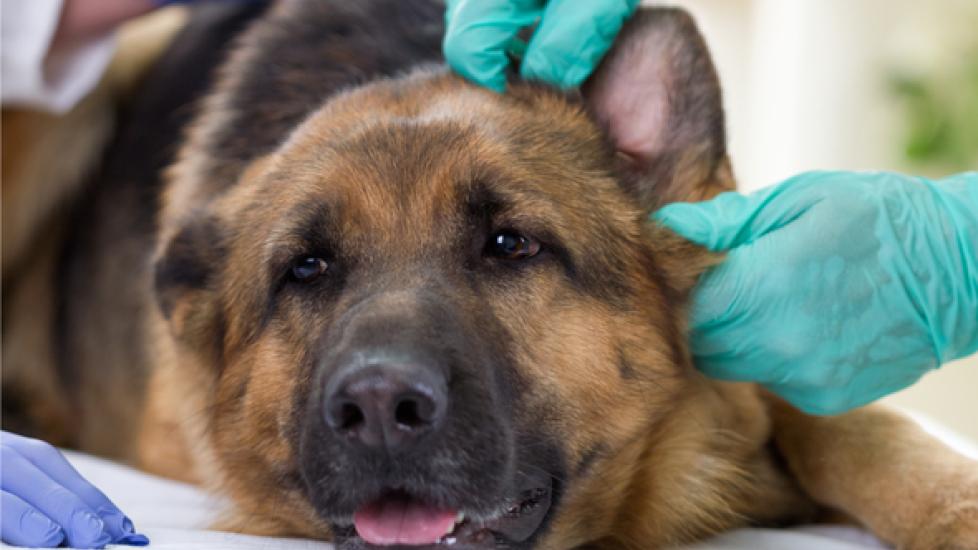Ear Tip Injuries in Pets
By Hanie Elfenbein, DVM
A lot of pet parents have experience with ear infections in dogs, but ear tip injuries present a different set of challenges and discomfort for our canine companions.
The most common cause of ear tip injury is an ear infection that induces a dog to shake his head vigorously. Sometimes this results in a tear on the ear, and other times it forms a blood blister. Any activity where your dog’s soft ears encounter something rough or sharp, such as rough play or running through the woods and getting cut by a branch, can also lead to ear injuries.
Ears are very vascular, meaning there is a strong blood supply flowing through them. This results in what looks like a lot of blood coming from even a small tear or cut. And it can make quite a mess if your dog shakes his head while his ears are bleeding. The good news is that he is very unlikely to lose enough blood from his ears to make him sick, so long as you take proper steps to address the problem.
Treating Ear Tip Injuries in Dogs
Unfortunately, ears are notorious for slow and poor healing ability because dogs are constantly moving them around and disrupting the healing process. Scabs are an important early step toward healing, but they come off easily if the dog shakes his ears. Then the blood starts coming out again, and you have to start the process all over.
Similarly, if a blood blister forms, simply draining it may not be enough. Known as auricular hematomas, these often recur and require intervention by your veterinarian. Auricular hematomas are blood-filled cysts usually located on the inside of the pinna (the soft outer part of the ear). They are most likely to occur in dogs with thin ears. Your veterinarian will drain the hematoma and place stitches in the blistered area to help the skin heal back down to the underlying tissue. This is done while your dog is sedated or anesthetized. Your veterinarian may also place a temporary drain, depending on factors like location, size, and how often your dog gets auricular hematomas.
For these types of injuries to heal, the area needs to be kept clean, dry, and immobile. Easy to say, harder to do. Bandages don’t stick to dogs’ ears, and they fall off easily if your dog scratches or shakes his head. Be patient. Dogs are often resistant to having their ears wrapped, but it is the only way to keep them from re-injury. You may need to get creative with various types of first aid bandages, bandanas, sweat bands, or other objects that can keep your dog’s ears immobile without being too bothersome.
Some people find that snoods (a piece of fabric designed to keep long ears from getting in food and water) work well, but they do not completely immobilize the ears. That may be enough for your dog, but it does not work for all dogs. Your pet may require a disproportionate amount of bandaging for a small wound, but don’t be discouraged.
Another common at-home remedy is liquid bandage, but this comes with a caution. To use it, the wound needs to be small, very clean, and dry. These are hard to accomplish at home. The last thing you want to do is trap bad bacteria in your dog’s wound. Your veterinarian and her staff are better equipped to adequately clean the wound and apply powders to help healing before using liquid bandage material and wrapping securely.
Other Types of Ear Injuries in Dogs
There are other things that can cause lesions to your dog’s ears that require a different type of treatment. Parasites like mange and biting flies can cause damage to your dog’s ears. A few breeds (for example, Dachshunds) tend to develop damage to the small blood vessels of the pinna due to vasculitis. This is a rare ear problem, and you should make an appointment with your veterinarian if you suspect your dog has this condition.
Not all lumps on your dog’s ears are benign. Any cancer that can form on skin can form on the pinna. Blood vessels in the ear can also become cancerous. If you notice any lumps or bumps on your dog’s pinna, have your veterinarian examine it, especially if the lump changes size, shape, or color, or ulcerates.
It is important to have your dog evaluated by your veterinarian if he develops an ear injury, especially if you don’t know how it happened or if it becomes recurrent. There are many causes of ear injuries that can all look the same. Your veterinarian is trained to determine the cause and treat it appropriately.
